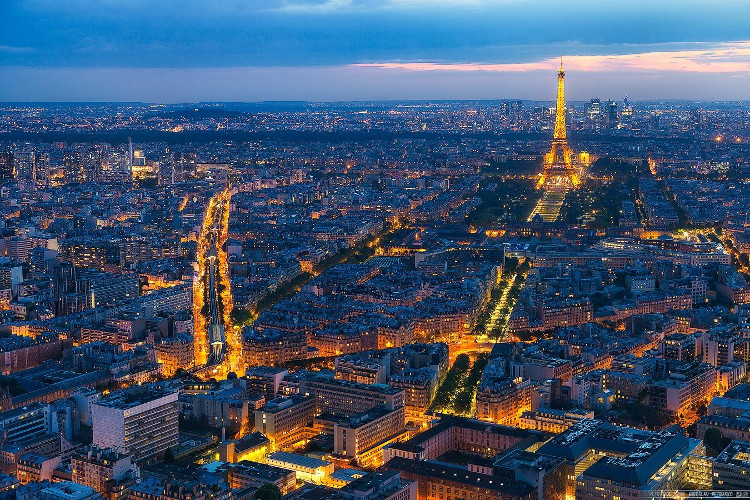The power requirements of the Paris and Greater Paris regions could grow by 4,000 MW by 2030. To manage this increase, Smart Grids are being used through multiple large-scale projects to improve management of the Parisian electricity network.

View of Paris and the Champs de Mars – Photo credit Miroslav Petrasko in CC
Enedis will invest 500 million euros in Greater Paris over next 15 years
According to Enedis, transport demands in Greater Paris, notably with the Grand Paris Express, will account for 400 to 500 MW by 2030; electric mobility on roads around 500 MW; around 800 MW for the 800 000 new houses to be built, 1,300 MW for the tertiary and industrial sectors; and new data centers to about 1,000 MW. To cope with this situation, Enedis is preparing to invest approximately 500 million euros a year over the next 15 years in Greater Paris.
The current reconfiguration of the Paris metropolis is giving rise to several Smart Grids initiatives.
Half a million euros invested by RTE for the modernization of the Greater Paris network
To support the development of urban and economic hubs in Greater Paris, RTE has implemented a ten-year plan with a high level of investment in the Île-de-France region. After spending 116 million euros in 2013 and 124 million euros in 2014, RTE will invest 510 million euros by 2020.
Hence, the new hubs such as Asnières and Nanterre are compact and integrated in urban areas as buildings. This compact mode will be systematically given preference in the future. RTE will also act in collaboration with major developers (Société du Grand Paris, Mobilités Ile-de-France, etc.). More efficient cables, facilities to manage the intermittency of renewable energies, devices facilitating the peak shaving of consumption, smart stations, open access to data … reinforced intelligence to control the consumption of energy or even the use of new infrastructure, at a controlled cost.
Cordees : a smart energy network in Paris
The city of Paris and its partners are among the winners of the “Innovative Urban Actions” European call for projects. The 4.3 million euros already allocated by the European Union will make it possible to realise the first smart energy network project in Paris, in the Clichy-Batignolles district.
Named Cordees (Co-Responsibility in Energy Efficiency District & Sustainability), this network is based on a platform that will consolidate all the energy data of 12 real estate programs: consumption, peak consumption, production, level of autonomy, storage capacity, … “This platform, led by a neighborhood energy facilitator, will test a new collaborative governance that involves the co-responsibility of actors involved in energy performance,” says the city of Paris.
Currently under construction, the Clichy-Batignolles eco-district will be completed in three years’ time. With its 3,400 housing units, 140,000 m² of offices, 38,000 m² of public facilities, 31,000 m² of retail space and culture and leisure spaces, the site has ambitious targets in terms of reducing greenhouse gas emissions. The thermal performance of buildings will already reduce heat loss. Heating and domestic hot water will come mainly from geothermal energy. Public lighting or the consumption of elevators will be offset by electricity generated from 40,000 m² of photovoltaic roofs spread over different buildings.
The Cordees project brings together the City of Paris, the development company of Clichy-Batignolles (Paris Batignolles Aménagement), the Embix cabinets and another city as well as the Ecole des Mines de Paris (Armines ParisTech).
Challenge DataCity in Paris: four projects around energy
DataCity is an open innovation program created by NUMA and the Paris City Council (Mairie de Paris ) that brings together industrial players, startups, and local authorities. For its second annual edition, the DataCity Challenge has selected ten projects, including four around energy.
- The Danish start-up Linc, in partnership with EDF, was chosen to develop an electricity exchange system by minimizing costs with Bouygues Energies & Services and Nexity.
- Two French startups, Quantmetry and Dataiku, will jointly develop an adaptive street lighting system to study urban movement data in partnership with Bouygues Energies & Services and SFR.
- Saagie, for its part, is working on optimizing the maintenance needs of street lighting infrastructures. In collaboration with Bouygues Energies & Services, the young company wants to build a predictive maintenance platform that will make it possible to visualize the malfunctions on the lampposts of the city of Paris.
- Finally, BeeBryte proposes to save energy in the buildings of the Paris City Hall thanks to sensors and meters.
These companies have two months to work on their challenge with the company that sponsors them, and to propose concrete solutions to the issues raised by DataCity. They will test a first version of their solution in Paris infrastructure (town hall, crèches, etc.) from 2017.
EDF and Grand Paris Habitat join forces to imagine smart buildings
Grand Paris Habitat, an operator dedicated to the production of housing and the revaluation of heritage in Greater Paris, has partnered with EDF to design buildings that rely in particular on the development of smart energy networks. “If both can operate separately, there is a real added value to having intelligence in the building to optimize the use of energy, adapt consumption to external conditions, integrate renewable energies or master peak consumption or local production. The combination of these products will make it possible to design a common smart building offer by offering shared energy pooling services”.
ITEMS International for Think Smartgrids



